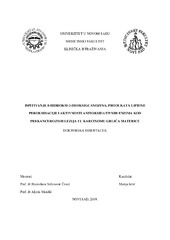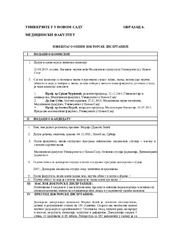Приказ основних података о дисертацији
Ispitivanje 8-hidroksi-2-deoksiguanozina, produkata lipidne peroksidacije i aktivnosti antioksidativnih enzima kod prekanceroznih lezija i u karcinomu grlića materice
Analysis of 8-hydroxy-2-deoxyguanosine, lipid peroxidation products and activity of antioxidative enzymes in precancerous lesions and in cervical cancer
| dc.contributor.advisor | Srđenović-Čonić, Branislava | |
| dc.contributor.advisor | Mandić, Aljoša | |
| dc.contributor.other | Đurđević, Srđan | |
| dc.contributor.other | Suđi, Jan | |
| dc.contributor.other | Purać, Jelena | |
| dc.contributor.other | Srđenović-Čonić, Branislava | |
| dc.contributor.other | Mandić, Aljoša | |
| dc.creator | Jelić, Marija | |
| dc.date.accessioned | 2019-07-18T12:48:03Z | |
| dc.date.available | 2019-07-18T12:48:03Z | |
| dc.date.available | 2020-07-03T13:27:52Z | |
| dc.date.issued | 2019-06-21 | |
| dc.identifier.uri | https://nardus.mpn.gov.rs/handle/123456789/11239 | |
| dc.identifier.uri | https://www.cris.uns.ac.rs/DownloadFileServlet/Disertacija155230505728641.pdf?controlNumber=(BISIS)110296&fileName=155230505728641.pdf&id=12688&source=NaRDuS&language=sr | sr |
| dc.identifier.uri | https://www.cris.uns.ac.rs/record.jsf?recordId=110296&source=NaRDuS&language=sr | sr |
| dc.identifier.uri | https://www.cris.uns.ac.rs/DownloadFileServlet/IzvestajKomisije155230506719620.pdf?controlNumber=(BISIS)110296&fileName=155230506719620.pdf&id=12689&source=NaRDuS&language=sr | sr |
| dc.description.abstract | U organizmu se, pod fiziološkim uslovima, produkuju slobodni radikali. Iako se u organizmu nalaze u veoma niskoj koncentraciji, slobodni radikali mogu ispoljiti toksične efekte. Težeći da spare elektrone, u hemijskoj reakciji oksidacije, dolazi do brzog i nepredvidivog vezivanja za susedne molekule, proteine, lipide, ugljene hidrate i nukleinske kiseline od kojih su sačinjeni strukturni elementi ćelije, pokrećući unutrašnji put apoptoze. Antioksidansi su supstance koje sprečavaju ili značajno smanjuju oksidaciju biomolekula. Oksidativni stres je stanje koje nastaje kada produkcija slobodnih radikala premaši kapacitete antioksidativnih enzima da ih neutrališu. U antioksidativne enzime spadaju: superoksid dismutaza (SOD), katalaza (CAT), glutation peroksidaza (GPx), glutation reduktaza (GR) i glutation-S-transferaza (GST). Lipidna peroksidacija (LP) je proces oksidacije višestruko nezasićenih masnih kiselina od strane slobodnih radikala. Malondialdehid predstavlja biohemijski marker pomoću kog je moguće meriti stepen oksidativnog oštećenja ćelijskih membrana. Oksidativna modifikacija DNK dovodi do promene strukture DNK koje rezultuju genetskim oštećenjima. Najčešće korišćen marker oksidativnog stresa je urinarni 8-hidroksi-2-deoksiguanozin (8-OHdG). Oštećenja proteina, lipida, DNK čine važan osnov mnogih oboljenja kao što su ateroskleroza, neurodegenerativna oboljenja, dijabetes, gojaznost, proces starenja, retinopatija, hronične inflamatorne bolesti i karcinom. Polazeći od hipoteze da su ovi biomolekuli različiti u različitim stadijumima bolesti, oni bi mogli predstavljati prognostički marker proširenosti bolesti. Cilj istraživanja je bio da se ispita da li postoje razlike između kontrolne grupe (zdravih žena), pacijentkinja sa prekanceroznim lezijama na grliću materice (HSIL), pacijentkinja sa lokalno ograničenim (FIGO Ia-Ib) i pacijentkinja sa lokalno uznapredovalim karcinomom grlića materice (IIa-IV) u pokazateljima oštećenja DNK (određivanjem vrednosti 8-OHdG), pokazateljima oksidativnog stresa (određivanjem intenziteta lipidne peroksidacije (TBARS)), pokazateljima antioksidativne odbrane (određivanjem aktivnosti antioksidativnih enzima superoksid dismutaze (SOD), katalaze (CAT), glutation peroksidaze (GPx), glutation reduktaze (GR) i glutation-S-transferaze (GST)). Pored toga, cilj istraživanja je bio da se uporede vrednosti 8-OHdG, proizvoda lipidne peroksidacije (TBARS) i aktivnosti antioksidativnih enzima (SOD, CAT, GST, GPx, GR) unutar grupe pacijentkinja sa lokalno ograničenim karcinomom grlića materice podeljenih u dve podgrupe sa niskim i visokim rizikom u odnosu na relaps bolesti. Takođe, u radu je koreliran nivo 8-OHdG, MDA i antioksidativnih enzima sa relapsom bolesti. Istraživanje je izvedeno na Klinici za operativnu onkologiju, odeljenje za ginekologiju na Institutu za onkologiju Vojvodine, Zavodu za farmaciju Medicinskog fakulteta u Novom Sadu i Zavodu za zdravstvenu zaštitu radnika Novi Sad u periodu od 2013. godine do 2017. godine. Od ispitanica su prikupljani uzorci krvi i urina, pripremljeni na adekvatan način i čuvani na -80° do analiza. Aktivnost enzima antioksidativne zaštite, kao i intenzitet lipidne peroksidacije određivani su spektrofotometrijskim metodama, a koncentracija 8-OhdG određivana je gasnom hromatografijom uz masenu detekciju. Za sprovođenje istraživanja dobijena je saglasnost Etičkog odbora Instituta za onkologiju Vojvodine. Pokazano je da postoje statistički značajne razlike između kontrolne grupe (zdravih žena), pacijentkinja saprekanceroznim lezijama na grliću materice (HSIL), pacijentkinja sa lokalno ograničenim (FIGO Ia-Ib) u odnosu napacijentkinje sa lokalno uznapredovalim karcinomom grlića materice (IIa-IV) u pokazateljima oštećenja DNK (koncentracija 8-OHdG), pokazateljima oksidativnog stresa (intenziteta lipidne peroksidacije (TBARS)), pokazateljima antioksidativne odbrane (aktivnosti antioksidativnih enzima SOD, CAT i GST). Nisu pokazane razlike između ispitivanih grupa u aktivnosti enzima glutation peroksidaze (GPx) i glutation reduktaze (GR). Nisu pronađene razlike u koncentraciji 8-OHdG, proizvoda lipidne peroksidacije (TBARS) i aktivnosti antioksidativnih enzima (SOD, CAT, GST, GPx i GR) unutar grupe pacijentkinja sa lokalno ograničenim karcinomom grlića materice podeljenih u dve podgrupe sa niskim i visokim rizikom u odnosu na relaps bolesti. Aktivnosti CAT i GST bile najbolji prediktori rekurencije bolesti kod definisanih pacijentkinja. Na osnovu aktivnosti ova dva oksidativna enzima, separacija grupe pacijentkinja kod kojih nije došlo do rekurencije bolesti nakon perioda praćenja od ostale dve grupe kod kojih je došlo do rekurencije bolesti je bila moguća. Na osnovu dobijenih rezultata zaključuje se da je moguće koristiti navedene biomarkere kao dijagnostičke markere kod pacijentkinja sa karcinomom grlića materice. Ovi biomolekuli mogu pomoći lakšem svrstavanju pacijentkinja u određene grupe prema stadijumu bolesti, a sledstveno i bržem odabiru odgovarajućeg lečenja. Pored toga, pokazano je da su aktivnosti enzima CAT i GST prediktori rekurencije bolesti kod definisanih grupa pacijentkinja. | sr |
| dc.description.abstract | Free radicals are produced in our body under physiological conditions. Although in very low concentrations, they can show some toxic effects. While trying to bind electrons, in the chemical reaction of oxidation, they rapidly and unpredictably bind to adjacent molecules- proteins, lipids, carbohydrates and nucleic acids from which the structural elements of the cell are made, triggering the internal pathway of apoptosis. Antioxidants are substances that prevent or significantly reduce the oxidation of biomolecules. Oxidative stress is a condition that occurs when the production of free radicals exceeds the capacity of antioxidant enzymes to neutralize them. The antioxidant enzymes include: superoxide dismutase (SOD), catalase (CAT), glutathione peroxidase (GPx), glutathione reductase (GR), and glutathione-S-transferase (GST). Lipid Peroxidation (LP) is the process of oxidation of polyunsaturated fatty acids by free radicals. Malondialdehyde is a biochemical marker by which it is possible to measure the degree of oxidative damage of cell membranes. The oxidative modification of DNA leads to a change in DNA structure that results in genetic damage. The most commonly used marker of oxidative stress is urinary 8-hydroxy-2-deoxiguanosine (8-OHdG). The damage to proteins, lipids and DNA is an important basis for many diseases such as atherosclerosis, neurodegenerative diseases, diabetes, obesity, aging, retinopathy, chronic inflammatory disease and cancer. Starting from the hypothesis that these biomolecules are different at different stages of the disease, they could represent a prognostic marker of the progression of the disease. The aim of the study was to examine whether there were differences between the control group (healthy women), the patients with precancerous lesions on the cervix (HSIL), the patients with early stage cervical cancer (FIGO Ia-Ib) and the patient with locally advanced cervical cancer (IIa - IV) in the indicators of DNA damage (determining the value of 8-OHdG), indicators of oxidative stress (by determining the lipid peroxidation intensity (TBARS)), indicators of antioxidant defense (by determining the activity of antioxidative enzymes of superoxide dismutase (SOD), catalase (CAT), glutathione peroxidase GPx), glutathione reductase (GR), and glutathione-S-transferase (GST)). In addition, the aim of the study was to compare the values of 8- OHdG, lipid peroxidation products (TBARS) and the activity of antioxidant enzymes (SOD, CAT, GST, GPx, GR) within the group of patients with early stage cervical cancer divided into two subgroups- with low and high risk in relation to the relapse of the disease. The research was performed at the Clinic for operative oncology, Department of Gynecology at the Institute of Oncology of Vojvodina, Medical Faculty in Novi Sad, Department of Pharmacy and the Institute for Health Care of Novi Sad in the period from 2013 to 2017. Samples of blood and urine of the patients were collected, prepared adequately and stored at -80 ° until the analysis. The activity of the antioxidant enzymes as well as the lipid peroxidation were determined by spectrophotometric methods, and the concentration of 8-OHdG was determined by gas chromatography with mass detection. The approval of the Ethical Committee of the Institute for Oncology of Vojvodina was obtained before conducting the research. It has been shown that there are statistically significant differences between the control group (healthy women), patient with precancerous cervical lesions (HSIL), the patients with early stage cervical cancer (FIGO Ia-Ib) compared to a group of patients with locally advanced cervical cancer (IIa-IV) in indicators of damage to DNA (concentration of 8-OHdG), indicators of oxidative stress (lipid peroxidation (TBARS)), indicators of antioxidant defense (activities of antioxidant enzymes SOD, CAT and GST). There was no difference between the groups in activity of glutathione peroxidase enzyme (GPx) and glutathione reductase (GR). There were no differences in the concentration of 8-OHdG, lipid peroxidation products (TBARS) and the activity of antioxidant enzymes (SOD, CAT, GST, GPx and GR) within the group of patients with locally restricted cervical cancer divided into two subgroups with low and high risk in relation on relapses of the disease. CAT and GST activities were the best predictors of disease recurrence among defined groups. Based on the activities of these two oxidative enzymes, the separation of the group of patients who did not experience disease recurrence after a follow-up period from the other two groups in which recurrence of the disease occurred was possible. Based on the obtained results it is concluded that it is possible to use the studied biomarkers as diagnostic markers in patients with cervical cancer. These biomolecules can help in the patient's classification into certain groups according to the stage of the disease, and consequently the more efficient choice of appropriate treatment. In addition, CAT and GST enzyme activity have been shown to be predictors of disease recurrence in defined patient groups. | en |
| dc.language | sr (latin script) | |
| dc.publisher | Универзитет у Новом Саду, Медицински факултет | sr |
| dc.rights | openAccess | en |
| dc.rights.uri | https://creativecommons.org/licenses/by-nc-nd/4.0/ | |
| dc.source | Универзитет у Новом Саду | sr |
| dc.subject | oksidativni stres | sr |
| dc.subject | Oxidative Stress | en |
| dc.subject | Tumor | en |
| dc.subject | Local | en |
| dc.subject | Uterine Cervical Neoplasms | en |
| dc.subject | Neoplasm Staging | en |
| dc.subject | Neoplasm Recurrence | en |
| dc.subject | antioksidansi | sr |
| dc.subject | lipidna peroksidacija | sr |
| dc.subject | tumorski biomarkeri | sr |
| dc.subject | neoplazme grlića materice | sr |
| dc.subject | stadijum neoplazmi | sr |
| dc.subject | lokalna rekurencija tumora | sr |
| dc.subject | prognoza | sr |
| dc.subject | Antioxidants | en |
| dc.subject | Lipid Peroxidation | en |
| dc.subject | Biomarkers | en |
| dc.subject | Prognosis | en |
| dc.title | Ispitivanje 8-hidroksi-2-deoksiguanozina, produkata lipidne peroksidacije i aktivnosti antioksidativnih enzima kod prekanceroznih lezija i u karcinomu grlića materice | sr |
| dc.title.alternative | Analysis of 8-hydroxy-2-deoxyguanosine, lipid peroxidation products and activity of antioxidative enzymes in precancerous lesions and in cervical cancer | en |
| dc.type | doctoralThesis | en |
| dc.rights.license | BY-NC-ND | |
| dc.identifier.fulltext | https://nardus.mpn.gov.rs/bitstream/id/35244/IzvestajKomisije.pdf | |
| dc.identifier.fulltext | https://nardus.mpn.gov.rs/bitstream/id/35243/Disertacija.pdf | |
| dc.identifier.fulltext | http://nardus.mpn.gov.rs/bitstream/id/35243/Disertacija.pdf | |
| dc.identifier.fulltext | http://nardus.mpn.gov.rs/bitstream/id/35244/IzvestajKomisije.pdf | |
| dc.identifier.rcub | https://hdl.handle.net/21.15107/rcub_nardus_11239 |



